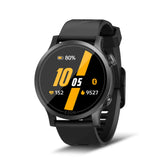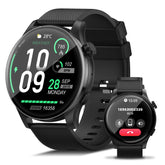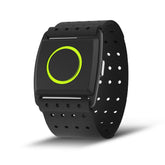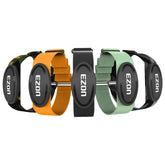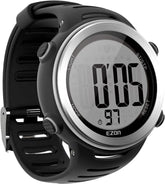Stress-Free Fitness: 5 Proven Ways to Release Pressure Through Exercise
In a world filled with deadlines and demands, stress can feel inescapable—but exercise offers a powerful antidote. Scientifically proven to reduce cortisol (the stress hormone) and boost endorphins, physical activity is more than just fitness; it’s a mental reset. This guide explores 5 evidence-based methods to melt stress through movement, paired with insights from stress tracking watches to balance intensity and recovery for holistic wellness.
1. Aerobic Exercise: Flood Your Brain with Endorphins
Why It Works
- Moderate-intensity cardio increases blood flow to the brain, triggering the release of serotonin and dopamine—neurochemicals that combat anxiety.
- A 2022 study in JAMA Psychiatry found 30 minutes of daily cardio reduces stress symptoms by 40% in just 8 weeks.
Best Practices
-
Heart Rate Zone 2 (60–70% Max HR):
- Activities: Running, cycling, swimming, or brisk walking—aim for 4–5 days/week.
- Tip: Use a stress tracking watch to ensure you’re in the “fat-burning zone,” where effort feels steady but sustainable (you can speak in full sentences).
- Example Workout: 45-minute bike ride at Zone 2, followed by 10 minutes of deep breathing to anchor the calm.
2. Mindful Movement: Yoga & Pilates for Mental Clarity
Why It Works
- Slow, intentional movements paired with focused breathing activate the parasympathetic nervous system (“rest and digest” mode), lowering heart rate and muscle tension.
- A 2021 meta-analysis linked regular yoga to a 35% reduction in perceived stress, thanks to improved body awareness and mindfulness.
Best Practices
-
Stress-Busting Poses:
- Child’s Pose: Relieves neck/shoulder tension; hold for 3–5 minutes.
- Legs-Up-the-Wall: Promotes venous return, reducing mental fatigue.
- Breathwork: Practice “4-7-8 breathing” (inhale 4s, hold 7s, exhale 8s) during or after sessions to deepen relaxation.
3. Heart Rate-Monitored Workouts: Train Smarter, Not Harder
Why It Works
- Matching effort to heart rate zones ensures you avoid overtraining (which increases stress) while maximizing stress relief.
- Zone 1 (50–60% Max HR): Perfect for recovery days (e.g., walking, gentle stretching), allowing the body to repair.
- Zone 3 (70–80% Max HR): Short tempo runs or HIIT bursts boost resilience to stress by improving cardiovascular efficiency.
How a stress tracking watch Helps
- Real-Time Alerts: Stay within optimal zones to prevent burnout—vibration notifications if you’re overworking.
- Stress Score: Some watches calculate stress levels via heart rate variability (HRV); use this to adjust workouts (e.g., swap HIIT for yoga if stress is high).
4. Strength Training: Build Resilience, Tame Cortisol
Why It Works
- Lifting weights reduces stress by regulating cortisol spikes, especially when paired with adequate rest.
- A 2019 study found resistance training lowers stress more effectively than cardio alone for those with high work pressure.
Best Practices
- Compound Movements: Squats, deadlifts, and push-ups engage multiple muscle groups, releasing myokines (proteins that improve mood).
- Moderate Intensity: 2–3 sets of 12–15 reps at 60–70% of your one-rep max—prioritize form over weight to avoid injury.
- Recovery Focus: Rest 48 hours between strength sessions; use a stress tracking watch to monitor resting heart rate— a drop indicates improved fitness.
5. Active Recovery: Prioritize Rest for Stress Balance
Why It Works
- Overtraining increases stress hormones; intentional recovery rebuilds mental and physical reserves.
- Sleep: 7–9 hours/night optimizes HRV, making you more resilient to daily stressors.
- Nature Time: 20 minutes of walking in green spaces lowers cortisol by 12%, according to the University of Michigan.
Strategies for Balance
- Foam Rolling: 10 minutes daily to release tight muscles (quads, upper back), improving mobility and mood.
- Meditation: 5–10 minutes of guided meditation post-workout—use apps like Headspace or your watch’s breathing feature.
-
Track Recovery Metrics:
- HRV: High HRV means your body is ready for intensity; low HRV signals the need for gentle movement (e.g., tai chi).
Tools to Enhance Stress-Free Fitness
A. Stress Tracking Watch Features to Look For
- 24/7 HRV Monitoring: Continuously assess stress levels to adjust routines in real time.
- Sleep Staging: Understand deep sleep duration, crucial for cortisol regulation.
- Guided Workouts: Preloaded stress-relief routines (e.g., recovery runs, yoga flows).
B. Practical Tips
- Morning Movement Rituals: 10 minutes of light exercise (stretching, walking) to set a calm tone for the day.
- Lunchtime Reset: A 15-minute walk or desk stretches to break up work stress.
- Evening Wind-Down: Gentle yoga or a warm bath to signal the brain it’s time to relax.
Train with Purpose, Live with Balance
Stress relief through exercise isn’t about perfection—it’s about consistency and listening to your body. By combining heart rate workouts with mindful movement, prioritizing recovery, and using a stress tracking watch to guide balance, you’ll transform fitness into a powerful stress management tool.
Remember, the best workout for stress is the one you enjoy—whether it’s a sunset run, a yoga flow, or a strength session. Let your watch be your coach, reminding you to push when you can and rest when you need to. With time, you’ll build not just physical strength, but the mental resilience to handle life’s pressures with ease.
EZON Watch: Professional sports technology brand
https://ezonwatch.com
https://ezonwatch.com
